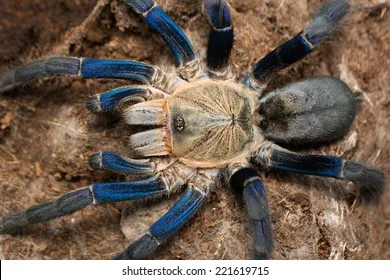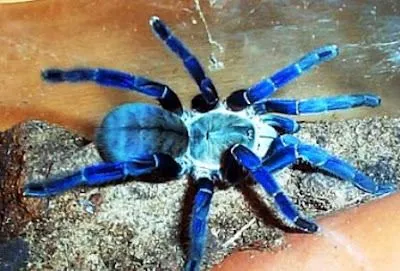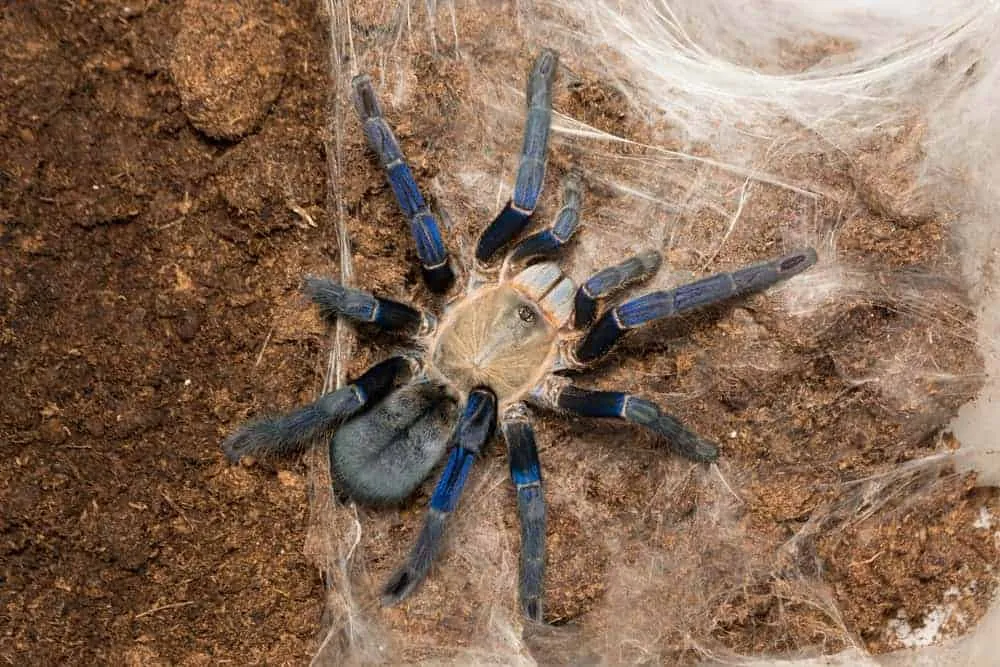Cobalt Blue Tarantula Feeding Top 5 Facts
The Cobalt Blue Tarantula (Cyaneopubescens) is a striking species, known for its vibrant blue coloration. Keeping these fascinating creatures requires careful attention to their needs, and feeding is one of the most critical aspects of their care. Understanding the right prey, frequency, and handling techniques ensures your tarantula thrives. This guide presents the top 5 facts essential for successfully feeding your Cobalt Blue Tarantula, helping you provide the best possible care for your pet. With these tips, you’ll be well-equipped to provide a long and healthy life for your colorful companion.
Fact 1 The Perfect Prey
One of the most crucial aspects of feeding a Cobalt Blue Tarantula is providing the right type of prey. These tarantulas are primarily insectivores, meaning their diet should consist mainly of insects. The most common and suitable prey items include crickets, roaches (such as Dubia roaches), and mealworms. These insects are readily available, relatively easy to care for, and provide the necessary nutrients for your tarantula’s growth and overall health. Always ensure the insects you offer are free from pesticides and other harmful substances to prevent potential health issues for your pet. A varied diet is also beneficial, so consider offering different types of insects to provide a range of nutrients.
What to Feed Cobalt Blue Tarantulas

Cobalt Blue Tarantulas thrive on a diet primarily consisting of insects. Crickets, readily available at most pet stores, are a staple choice. Roaches, particularly Dubia roaches, are another excellent option, offering high nutritional value and being less prone to escape compared to crickets. Mealworms can also be included, but in moderation, as they are higher in fat. Waxworms can be offered as occasional treats, but should not be a regular part of their diet. Ensure the insects are gut-loaded before offering them to your tarantula, meaning they are fed nutritious food to enhance their value.
Prey Size Matters
Prey size is critical when feeding Cobalt Blue Tarantulas. The insects should be no larger than the tarantula’s body size (excluding legs). Offering prey that is too large can stress the tarantula, making it difficult to handle and potentially leading to injury during the feeding process. For spiderlings and juveniles, smaller insects like pinhead crickets or small roaches are ideal. As the tarantula grows, the size of the prey can be gradually increased. Always observe your tarantula’s feeding behavior; if it seems uninterested or struggles to consume the prey, it is too large. Adjust the size of the prey accordingly to ensure your tarantula can feed comfortably and efficiently. (Image: cobalt_blue_tarantula_prey_size.webp)
Fact 2 Frequency is Key
The frequency of feeding your Cobalt Blue Tarantula depends on its age and growth stage. Spiderlings and juveniles require more frequent feedings than adults, as they are actively growing and need more energy. Overfeeding, however, can lead to obesity and other health problems. Understanding the appropriate feeding schedule is essential for maintaining your tarantula’s health and well-being. Adjust the frequency based on your tarantula’s appetite and molting cycle. Observing your pet’s behavior will give you the best insight into its feeding needs. Be aware that tarantulas often refuse food before molting.
Feeding Schedule for Cobalt Blue Tarantulas

Young spiderlings (up to 1 inch in leg span) should be fed 2-3 times per week. As they grow into juveniles (1-3 inches), the feeding frequency can be reduced to once or twice a week. Adult Cobalt Blue Tarantulas (over 3 inches) typically only need to be fed once every 1-2 weeks. Always remove any uneaten prey within 24 hours to prevent stress on the tarantula and to maintain a clean enclosure. This schedule is a general guideline; you might need to adjust it based on your tarantula’s specific needs and appetite. Avoid overfeeding, especially adult tarantulas, as this can lead to health issues.
Adjusting the Feeding Schedule
Several factors can influence the feeding schedule. The tarantula’s growth rate is a key indicator; faster-growing individuals may require more frequent feedings. The temperature of the enclosure also affects metabolism; warmer temperatures can increase appetite. Molting also affects feeding habits; tarantulas often refuse food for several weeks before molting. Always monitor your tarantula’s abdomen size; a plump abdomen indicates good health, while a thin abdomen may indicate insufficient feeding. Make sure to consider the size of the tarantula, and feed appropriately. (Image: cobalt_blue_tarantula_feeding_schedule.webp)
Fact 3 Hydration is Essential
Providing fresh water is critical to your Cobalt Blue Tarantula’s health and well-being. Tarantulas, like all living creatures, need water to survive. Ensuring a constant supply of clean water is an essential aspect of their care. Hydration is particularly important during molting, as it helps the tarantula shed its exoskeleton properly. Always have a shallow water dish available in the enclosure and refill it regularly. Neglecting hydration can lead to dehydration, which can be fatal.
Importance of Fresh Water

A shallow water dish is a must-have in your Cobalt Blue Tarantula’s enclosure. The dish should be small enough to prevent the tarantula from drowning but large enough to allow easy access to water. Use a dish that is easy to clean and made of a non-toxic material. Check the water daily and refill it with fresh, clean water. Avoid using tap water directly, as it may contain chlorine or other chemicals that could harm your tarantula. Using bottled spring water or filtered water is a better option. (Image: cobalt_blue_tarantula_water_dish.webp)
Preventing Dehydration
Dehydration is a serious threat to tarantulas, especially in dry environments. Apart from a constant water supply, you can maintain adequate humidity levels in the enclosure. This can be achieved by misting the enclosure with water, especially during the molting process. Ensure the substrate is slightly moist, but not wet, to prevent mold growth. Monitor the tarantula’s behavior; a lethargic tarantula or one with a wrinkled abdomen could be a sign of dehydration. If you suspect dehydration, provide extra water and increase humidity.
Fact 4 Handling and Feeding
Handling a Cobalt Blue Tarantula is generally not recommended due to their speed and potent venom. However, understanding safe handling practices is important, especially during feeding. It is crucial to prioritize your safety and the tarantula’s well-being. Proper techniques can prevent accidents and minimize the risk of bites. Approach feeding and handling with caution and respect for the tarantula’s natural behaviors. Always create a safe environment, and never force an interaction.
Safe Handling Practices

If handling is necessary, do so with extreme care. Never handle a Cobalt Blue Tarantula unless absolutely necessary. If you must handle it, do so over a soft surface like a bed or a container to minimize the risk of injury if the tarantula falls. Use a soft brush to gently encourage the tarantula to move. Avoid sudden movements and be mindful of the tarantula’s position. Always wash your hands thoroughly before and after handling to prevent the transfer of any contaminants or chemicals that can harm the tarantula. (Image: cobalt_blue_tarantula_handling.webp)
When to Avoid Feeding
There are times when feeding should be avoided. Tarantulas often refuse food before molting, so do not force feed. Also, avoid feeding if the tarantula is showing signs of illness or stress. During or after a molt, the tarantula’s fangs are still soft. Refrain from feeding during this period. The stress of the feeding process could be detrimental. If your tarantula has recently been handled, give it some time to settle and return to its normal behavior before attempting to feed. Observe the tarantula for any signs of stress.
Fact 5 Recognizing a Healthy Appetite
Observing your Cobalt Blue Tarantula’s appetite is essential for its well-being. A healthy tarantula will show a keen interest in food and actively hunt when offered prey. Recognizing the signs of a healthy appetite helps you maintain a balanced feeding schedule and avoid overfeeding or other potential issues. Knowing what to look for ensures that your tarantula receives the correct amount of nutrition to thrive. Pay close attention to your tarantula’s behavior, and the frequency in which it eats its prey.
Signs of a Hungry Tarantula

A hungry Cobalt Blue Tarantula will often display specific behaviors. It may be seen actively searching for food, wandering around its enclosure, or displaying an alert posture. When prey is introduced, a hungry tarantula will quickly and aggressively attack. Look for a willingness to grab the prey and start feeding immediately. A healthy abdomen that is not overly distended is another sign that your tarantula has a healthy appetite and is not overfed. Always be sure to remove uneaten prey after 24 hours, in case your tarantula isn’t hungry. (Image: cobalt_blue_tarantula_hungry.webp)
Signs of Overfeeding
Overfeeding can be detrimental to your tarantula’s health. Signs of overfeeding include a swollen abdomen and a lack of interest in food. The tarantula may refuse to eat even when prey is offered. Other signs include lethargy and a slow movement pace. Overfeeding can lead to health issues and potentially shorten the lifespan of your tarantula. If you suspect that your tarantula is overfed, reduce the feeding frequency and monitor its behavior closely. Remove any uneaten prey and ensure the tarantula has access to fresh water.
In conclusion, feeding your Cobalt Blue Tarantula is a critical aspect of its care, encompassing several key factors. Providing the correct prey, adjusting the feeding frequency based on the tarantula’s age and growth, ensuring proper hydration, handling safely, and understanding the signs of a healthy appetite are all essential. By following these guidelines, you can ensure your Cobalt Blue Tarantula thrives, displaying its vibrant colors and captivating behavior for years to come.
